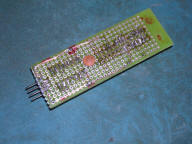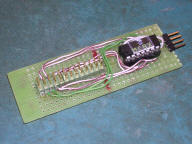Basis 108
Basis Microcomputer was a small company in West
Germany, who supplied Apple II computers and some industrial computers.
In early 1980s they wanted to make their own computer. This resulted in
Basis 108, an Apple II clone with Z80 CPU added as second to run CP/M
operating system. Basis 108 was designed with a big influence of
industrial computer design methods, as its case is very rigid (cast
aluminium) and heavy. Inside, an ordinary switching power supply is
located with two sockets to connect monitor and other peripherals. Some
Basis 108 units had original Apple II drives, other units like mine,
have Siemens drives with electronics manufactured by "erphi electronic".
To achieve compatibility with CP/M, Basis had an extended graphic card
supporting 80-column mode. CP/M Mode was selected by switch in front of the computer.
Basis 108 had cassette interface, serial and parallel port onboard.
Keyboard was external, connected with 7-bit parallel ASCII port.
| Manufacturer | Basis Microcomputer | |
| Origin | West Germany | |
| Year of unit | 1983 | |
| Year of introduction | 1983 | |
| End of production | ??? | |
| CPU | MOS 6502 and Zilog Z80. | |
| Speed | ~1MHz | |
| RAM | 128kB | |
| ROM | 12kB | |
| Colors: | 16 | |
| Sound: | One-channel built-in speaker. | |
| OS: | Apple DOS or CP/M | |
| Display modes: | Text: 40x24, 80x24 Graphics: 40,80x48x16, 140,280x192x16 |
|
| Media: | Built-in two 5.25" FDD | |
|
Power supply: |
||
|
Built-in switching power supply |
||
| I/O: | Keyboard (parallel 7-bit ASCII) Parallel port Serial port RGB out B/W video out NTSC video out Tape I/O Joystick (using IC socket) |
|
| Possible upgrades: | Al chips socketed, 6 Apple II slots. | |
| Software accessibility: | Easy (TOSEC, dedicated sites)
- Apple II software Impossible (proprietary software) |
My unit is highly modified, and it's probably a very early one. Small PCB converting RGB signal is made on universal PCB, not factory-made as in later computers. All chips are in sockets. The casing has two additional switches allowing to use double-sided disks in one-sided drive. And video card is connected with wires to pins on mainboard. One chip is added to the graphic card.
There was some licensing problems with Apple ROM in the earliest units, and these modifications may be result of it.
| Contents: | Starting | Keyboard |
Starting:
After turning on a beep or short series of beeps can be
heard fom speaker. "BASIS 108" text will be displayed.
If the unit has FDD controller, it'll try to boot from drive one by
spinning it.
If not, it goes to monitor software.
Keyboard
Keyboard is connected with the same parallel 7-bit ASCII interface as in some Apple II computers. The only difference is with STROBE signal which is inverted in BASIS.
|
|
| 1 - ? 2 - ? 3 - ? 4 - GND 5 - ? 6 - /Strobe latch out ** 7 - /STROBE * 8 - /RESET 9 - ?? D5-D7?? 10 - D5 11 - D3 12 - D1 13 - +12V 14 - ? 15 - ? 16 - ? 17 - ? 18 - ? 19 - GND 20 - +5V 21 - ??? (some signal?) 22 - D6 23 - D4 24 - D2 25 - D0 ** - not needed in original Apple II keyboard, not needed in adapter. Remember that in most BASIS 108 computers keyboard ribbon cable goes with marked wire 1 to wire labeled 26 on the mainboard! |
To connect PC keyboard, a microcontroller based solution must be used. The solution is based on an Apple II solution which can be found here. To program needed PIC16F676 in Willem programmer, Willem's software should NOT be used. This software does not erase PIC16F676 and may even damage its calibration value (last two bytes). You should use IC-Prog instead.


A whole thing can be mounted on a breadboard installed in the ribbon
cable of BASIS computer.






